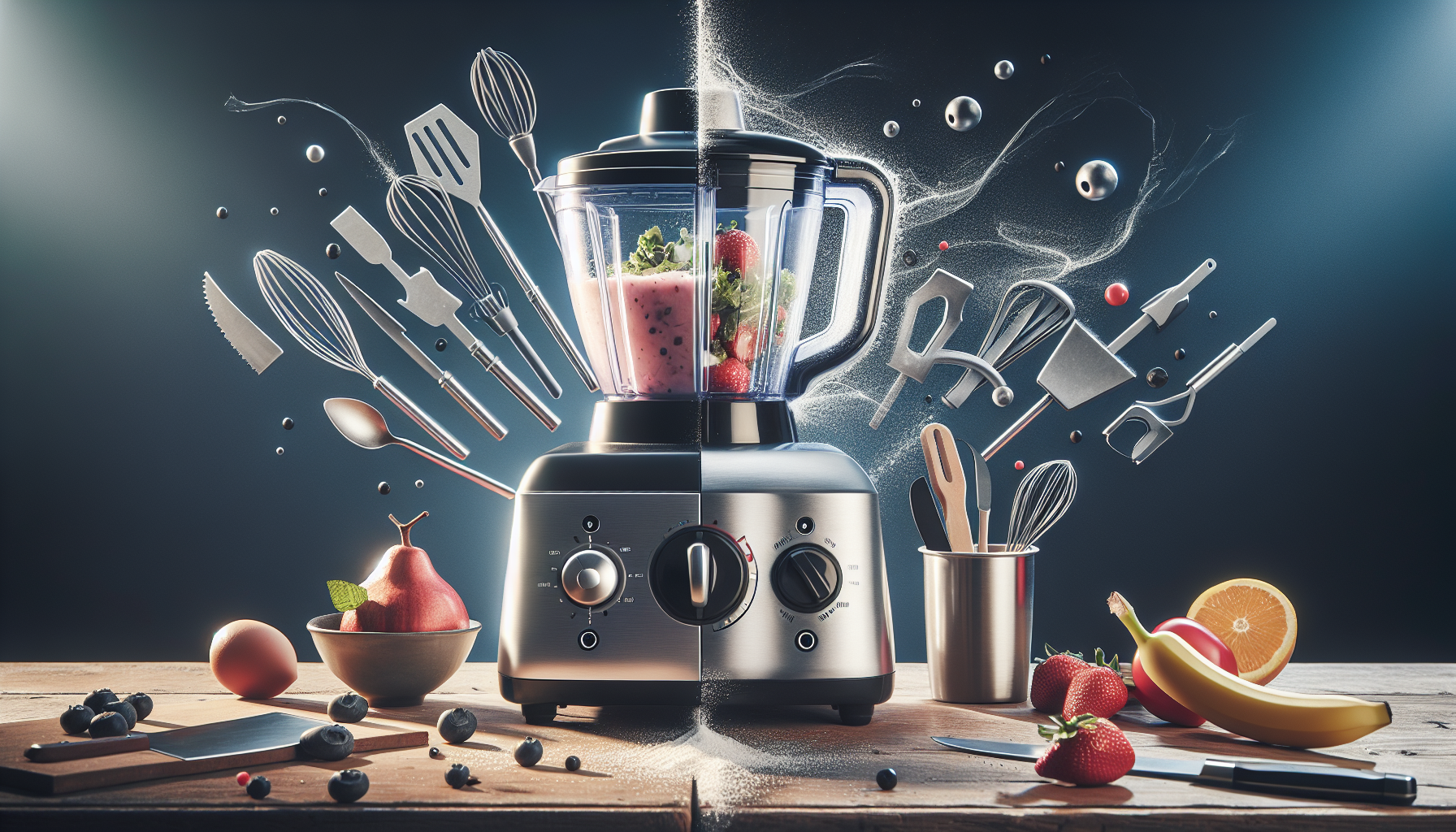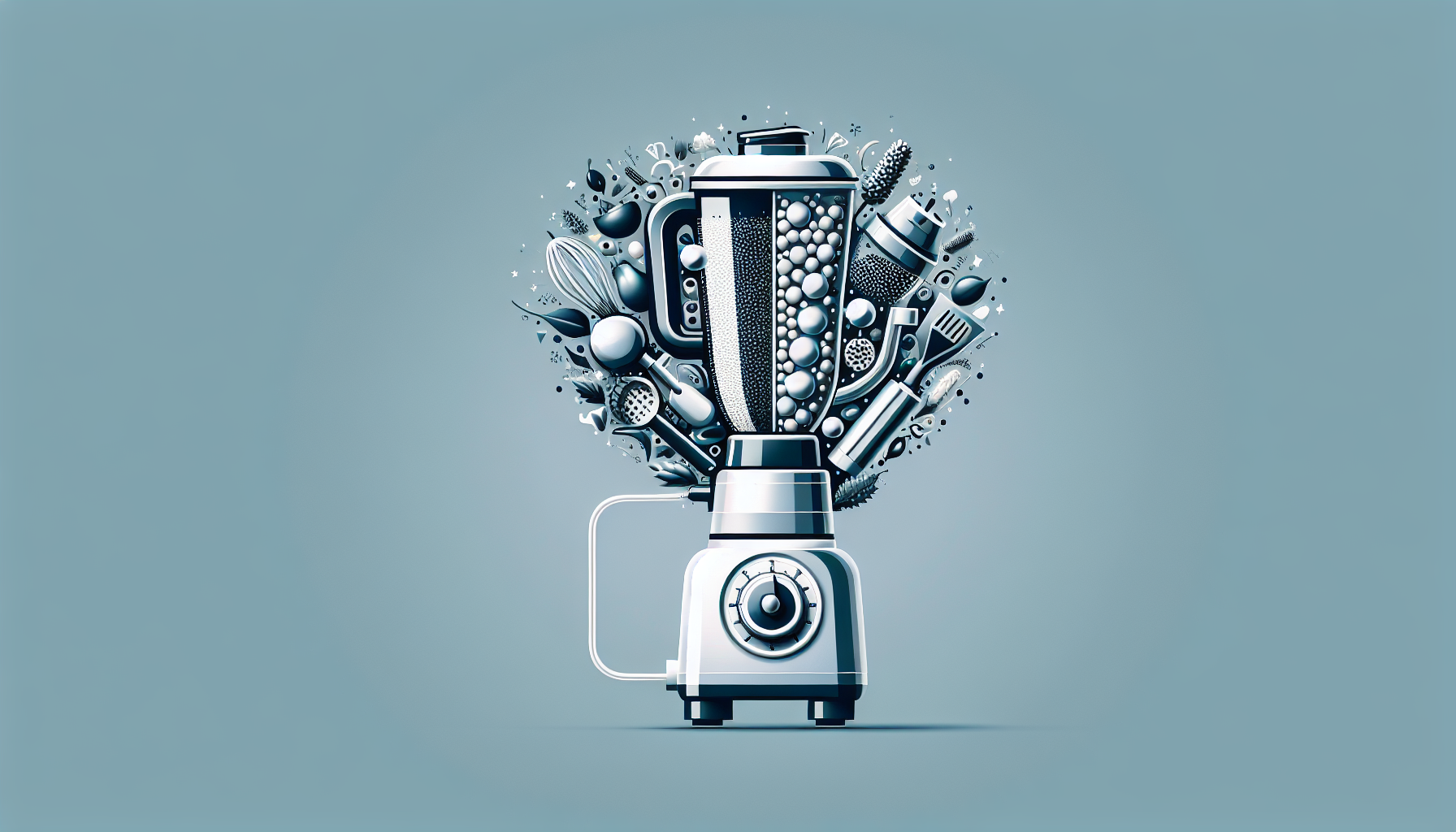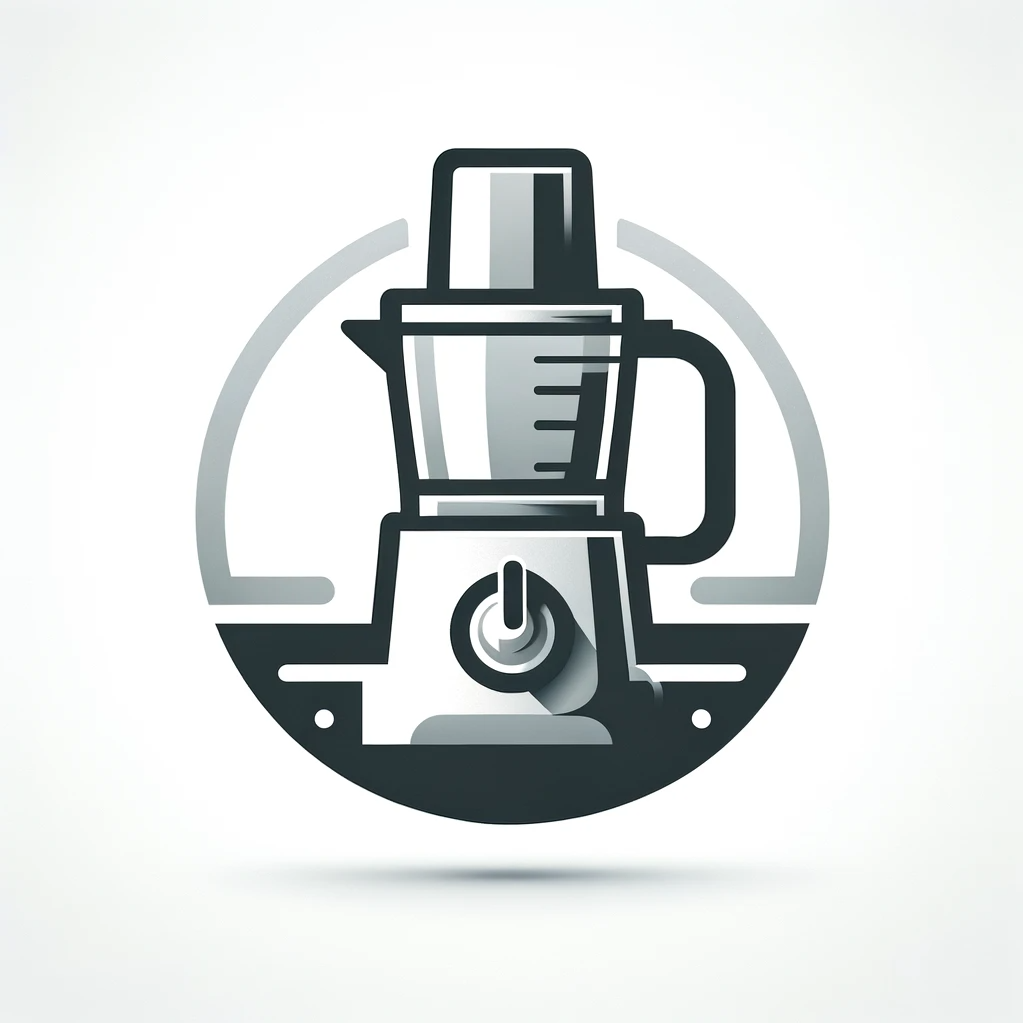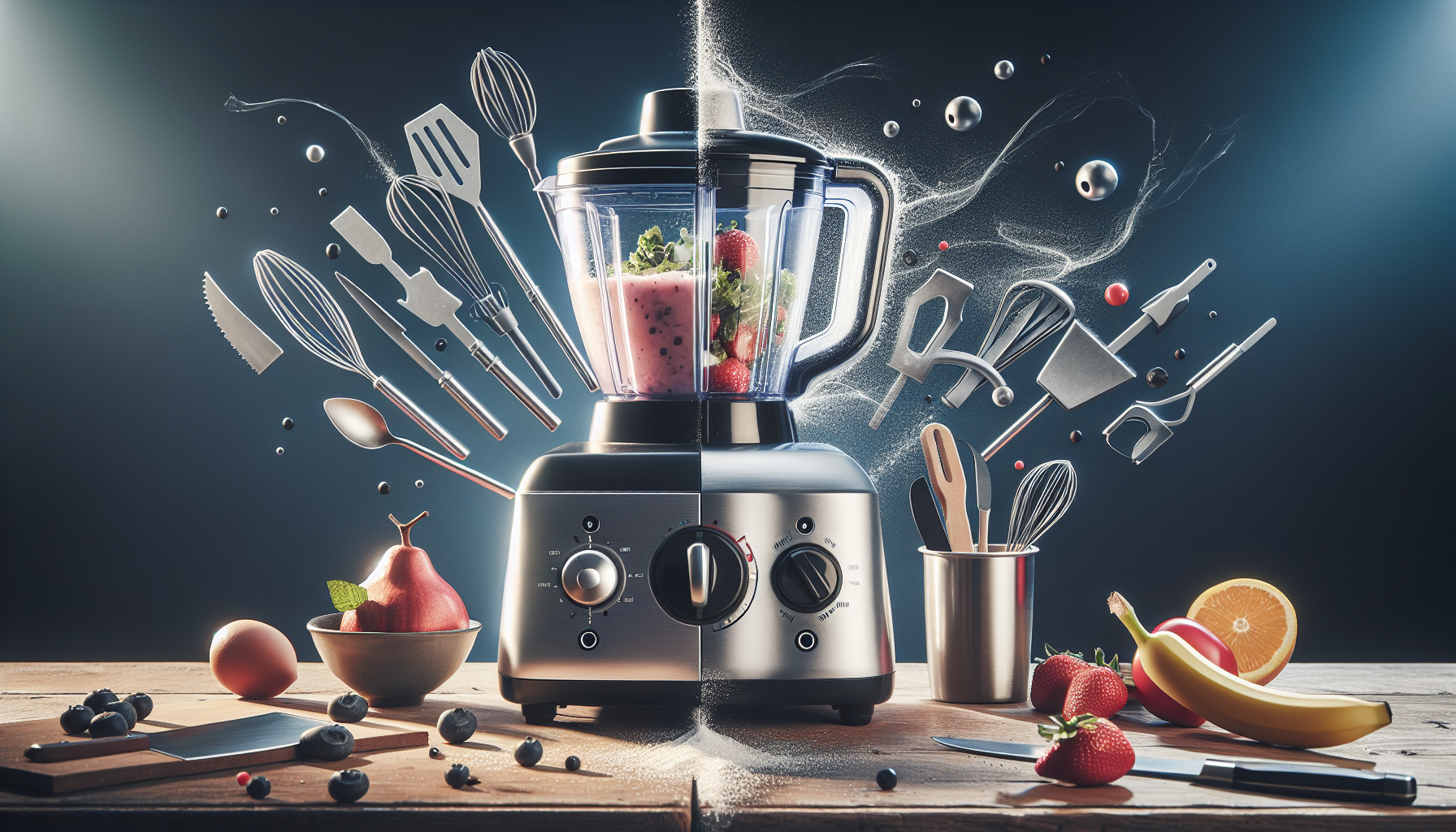Are you torn between choosing a food processor or a blender? Unsure which kitchen appliance would suit your needs best? In this article, we will explore the pros and cons of both the food processor and the blender, helping you make a well-informed decision. Whether you’re looking to chop vegetables, blend smoothies, or prepare soups, we’ll compare these two popular kitchen tools, ultimately guiding you towards making the right choice for your culinary adventures.

CHECK OUT FOOD PROCESSORS AND VEGETABLE CHOPPERS ON AMAZON
Power
Motor Power
When it comes to choosing between a food processor and a blender, one important consideration is the motor power. The motor power determines the efficiency and effectiveness of the appliance in performing various tasks. A more powerful motor allows for smoother blending, grinding, and chopping of ingredients. It also enables the appliance to handle tougher ingredients such as nuts or ice with ease. Therefore, when making your decision, consider the motor power of both the food processor and blender options you are considering, and choose the one that offers a higher motor power for better performance.
Blades
The blades play a crucial role in the functionality and versatility of both food processors and blenders. Food processors typically come with multiple interchangeable blades that can perform a variety of tasks like chopping, slicing, and grating. These blades can be easily switched out depending on the specific task at hand. On the other hand, blenders usually have fixed blades designed specifically for blending and pureeing. While blenders may not have as many blade options as food processors, they are highly efficient in creating smooth and consistent blends. Consider the types of blades available with both options and choose according to your specific needs and preferences.
Functionality
Chopping and Slicing
Food processors excel in tasks like chopping and slicing. With their versatile blades and powerful motors, food processors can quickly and efficiently chop vegetables, fruits, or even nuts. They can also slice ingredients into uniform pieces, making it easier to achieve desired cooking or presentation results. If you frequently prepare meals that require chopping or slicing, a food processor would be a better choice for you.
Blending and Pureeing
Blenders, on the other hand, are designed primarily for blending and pureeing. Whether you are making smoothies, soups, or sauces, blenders can effortlessly combine ingredients into a smooth and consistent texture. They excel in breaking down fruits, vegetables, and other ingredients to create a liquid or semi-liquid consistency. If your main purpose is to blend or puree ingredients, a blender will be the more suitable option for your needs.
Grinding and Milling
If you often find yourself needing to grind or mill ingredients, such as spices or grains, a food processor is the preferable choice. Food processors often come with specific blades and attachments for grinding and milling. These blades and attachments allow you to transform whole spices or grains into fine powders or flours with ease. Blenders, on the other hand, may not have the necessary attachments or blades for grinding or milling tasks, making food processors the more versatile option for these functions.
Capacity
Bowl Size
Another factor to consider when choosing between a food processor and a blender is the capacity, specifically the bowl size. Food processors generally offer larger bowl sizes compared to blenders. This larger capacity enables you to process larger quantities of ingredients at once, which can be particularly useful when preparing meals for a larger family or for entertaining guests. If you often find yourself needing to process large quantities of ingredients, a food processor with a larger bowl size would be a better choice for you.
Jar Size
Blenders typically come with a jar instead of a bowl. The jar size may vary depending on the specific blender model. If you primarily use your appliance for making individual smoothies or small batches of sauces, a blender with a smaller jar size would be sufficient for your needs. However, if you frequently prepare recipes that require larger quantities, such as soups or dips, you may want to consider a blender with a larger jar size or opt for a food processor with its larger capacity.

CHECK OUT FOOD PROCESSORS AND VEGETABLE CHOPPERS ON AMAZON
Versatility
Attachments and Accessories
When it comes to versatility, food processors often have the upper hand. Food processors typically come with a variety of attachments and accessories that allow for a wide range of culinary tasks. These attachments can include blades for slicing, chopping, and grating, as well as additional attachments for kneading dough or juicing fruits. With the right attachments, a food processor can replace several other kitchen appliances, saving you both space and money. Blenders, on the other hand, may have fewer attachments available, limiting their versatility to primarily blending and pureeing tasks. Consider the attachments and accessories available with each option and choose the one that offers the versatility you desire in your kitchen.
Control and Settings
Speed Settings
Having control over the speed settings of your appliance can greatly enhance your cooking and blending experience. Food processors and blenders often come with multiple speed settings, allowing you to adjust the speed according to the specific task at hand. This flexibility enables you to achieve the desired texture and consistency for your recipes. Whether you need a slow, gentle blend or a high-speed chop, being able to control the speed helps you achieve optimal results. Consider the number and range of speed settings available with each appliance and choose the one that offers the level of control you need for your culinary adventures.
Pulse Function
In addition to speed settings, many food processors and blenders also come with a pulse function. The pulse function allows you to quickly and easily control the processor or blender in short bursts. This function is particularly useful when you need to achieve precise results or when you want to avoid over-processing ingredients. The pulse function enables you to have greater control over the texture and consistency of your preparations. If you value having this level of control, make sure to choose an appliance that includes a pulse function.
Ease of Use
Assembly and Disassembly
The ease of assembly and disassembly can greatly impact your overall experience with a food processor or blender. Both appliances should be designed for easy setup and breakdown, allowing for a hassle-free cooking process. Food processors typically have multiple parts, including the bowl, lid, and various attachments. Look for a food processor that offers a straightforward assembly process, with parts that easily click into place. Blenders, on the other hand, usually have a simpler setup with fewer components. Ensuring that the blender jar fits securely onto the base is essential for safe and efficient blending. Consider the assembly and disassembly process of each appliance and choose the one that offers ease of use for your convenience.
Cleaning
After using any kitchen appliance, cleaning is an essential step. Food processors and blenders should be easy to clean, saving you time and effort in the kitchen. Most parts of food processors and blenders are dishwasher-safe, allowing for convenient cleaning. However, some parts may need to be hand-washed, so it’s important to check the specific cleaning instructions for each appliance. Consider the ease of cleaning for both the food processor and blender options you are considering and choose the one that fits your cleaning preferences and lifestyle.
Cost
Price Range
Price is often a deciding factor when it comes to choosing between a food processor and a blender. Food processors generally tend to be more expensive than blenders due to their additional functionalities, attachments, and larger capacity. Blenders are usually more budget-friendly, especially if you are looking for a basic model with fewer features. Consider your budget and compare the price ranges of the food processor and blender options available to find the best fit for your needs.
Value for Money
While considering the cost, it’s also important to evaluate the value for money that each appliance offers. Take into account the features, functionalities, and durability of the options you are considering. A higher-priced appliance may provide more durability, versatility, and additional attachments, making it a better investment in the long run. On the other hand, a lower-priced appliance may still fulfill your basic needs without breaking the bank. Find the balance between cost and value for money that aligns with your specific requirements.
Size and Storage
Dimensions
When it comes to kitchen appliances, size does matter. Before making a decision, consider the dimensions of both the food processor and blender options you are considering. Food processors tend to be larger in size due to their additional attachments and larger capacity. Ensure that you have sufficient counter or storage space to accommodate the size of the food processor you choose. Blenders, on the other hand, are generally more compact and take up less counter space. Evaluate the available space in your kitchen and choose an appliance that fits comfortably within your designated area.
Storage Options
Considering storage options is also important, especially if you have limited cabinet or counter space in your kitchen. Food processors often come with additional attachments and accessories that need to be stored. Look for a food processor that provides storage options, such as a designated storage container or attachment holder, to keep all the components organized and easily accessible. Blenders, with their simpler design, may require less storage space and can often be stored without the need for additional containers. Assess your storage needs and choose an appliance that offers convenient storage options for your specific kitchen setup.
Durability
Build Quality
Durability is an important factor to consider when investing in a food processor or blender. Look for appliances that are built with high-quality materials, such as stainless steel or BPA-free plastic, to ensure longevity. Pay attention to the construction of the blades, as they should be sturdy and resistant to breakage. Read reviews and consider the reputation of the brand to gauge the overall build quality of the appliance. A durable appliance will not only last longer but also provide consistent performance over time.
Warranty
To further ensure the durability of your chosen appliance, check the warranty provided by the manufacturer. A warranty indicates the confidence of the manufacturer in the quality and durability of their product. Look for food processors and blenders that come with a warranty, preferably for a reasonable length of time. A good warranty offers peace of mind, as it protects you from any manufacturing defects or malfunctions. Take into account the warranty coverage offered for both food processors and blenders, and choose the one that provides the best warranty terms within your budget.
Final Verdict
Conclusion
In conclusion, choosing between a food processor and a blender ultimately comes down to your specific needs and preferences in the kitchen. Consider the factors discussed, such as motor power, functionality, capacity, versatility, control and settings, ease of use, cost, size and storage, and durability. Assess your cooking habits, the types of recipes you frequently prepare, and the space available in your kitchen. By carefully weighing these factors, you can make an informed decision and select the appliance that best suits your cooking style and requirements. Whether you choose a food processor or a blender, both can greatly enhance your culinary adventures and offer convenience and efficiency in the kitchen. Happy blending and processing!

